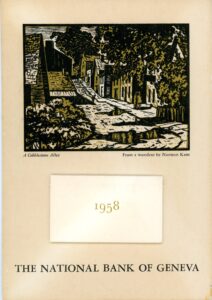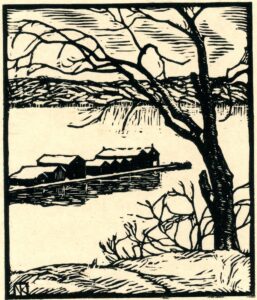Norman Kent
By Elizabeth Nafz, Intern
Norman Kent (1903-1972), an American artist known for relief printmaking, captured the picturesque beauty of Geneva and the broader Western New York region in his art. Known for his depictions of small American landscapes and towns, Kent also excelled in portraiture and promotional prints.
Born in Pittsburgh, Pennsylvania, Kent pursued his artistic talents at Rochester Institute of Technology, receiving his degree in 1925. From there, he studied at the Arts Students League of New York under the mentorship of muralist William De Leftwich Dodge and printmaker Arthur Allen Lewis. During the late 1920s and early 1930s, Kent spent his time freelancing in Buffalo, New York and Rome, Italy before coming to Geneva. From 1934 to 1943, Kent was an art professor and managed the College Gallery at Hobart and William Smith Colleges. While in Geneva, he created prints for The National Bank of Geneva and for pleasure. He spent the remainder of his life in Mamaroneck, NY as a freelance artist as well as a writer and editor for art magazines and books.
Relief printing involves cutting away lines from a block of wood or linoleum. The remaining pieces get covered in ink, resulting in the print. Due to the constraints of a carving knife, prints use lines to create shapes and texture. Actual lines make up architectural and human features while implied lines create texture and dimension. Norman Kent preferred to use plankwise Gumwood for making wood cuts because, as he put it, “the limitation of this softer medium forces me to design my prints with greater simplicity, and to use black and white more conventionally than naturalistically.” The simplistic and naturalistic style produced by these elements of art worked in favor of Kent’s subjects. He often depicted small towns with nostalgic charm and beauty. Kent’s content includes snow covered bridges, brick buildings, and boats on a lake, all forms that function well with the limitations of printmaking.
While in Geneva, Kent worked with The National Bank to create yearly calendars that featured an original print of a historically significant spot in Geneva. The series resulted in charming scenes that celebrate and idealize Geneva’s past in relation to the history of The National Bank. In 1958, the calendar focused on Cobblestone Alley, a road no longer in Geneva. Similarly, in 1960, Kent created a woodcut of Long Pier showing what the area looked like in the early years of Geneva’s history. He also chose locations of the past that are around today, such as Pulteney Square, for the 1943 calendar.
Between his work at the Colleges and printmaking scenes of Geneva, Kent’s impact on the town is significant. His depictions of Rochester, Buffalo, Italy, Geneva, and Mamaroneck evoke nostalgic emotions and an appreciation for architecture and nature. Norman Kent’s prints can be found in museums around the nation, online auctions, and various books.
Elizabeth Nafz was a 2022 summer archivist intern at Historic Geneva. She is a Junior at Hobart and William Smith majoring in history and minoring in art history.




Thanks Elizabeth.
Very good and informative.
I have one of his woodcuts, created while at the Colleges from 1940,
named The Nudes.
Elizabeth, Very good article and very informative. Norman Kent also did a series of woodcut prints of the Pleasant Valley Wine Company in Hammondsport, NY. I remember seeing these, I believe in the GHS collection.
Very interesting article. Thanks so much. I have 2 prints: South Main St. and Park Place. I remember when his daughter visited the Colleges and brought some prints. Shari Best
Nice article. Norman was a distant cousin of mine. I have a woodcut he did of the Kent family home (Greek Revival) in Bentleyville, OH.
I was fortunate enough to find a set of prints from the Pleasantville Winery. They are lovely. I love wood prints!!!
Considering framing them for my sons wedding.